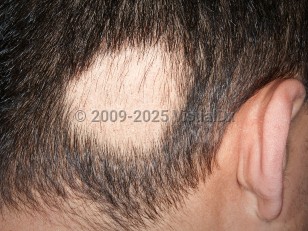Alopecia areata in Infant/Neonate
See also in: External and Internal Eye,Hair and Scalp,Nail and Distal DigitAlerts and Notices
Important News & Links
Synopsis

Alopecia areata is seen equally in both sexes and in patients of all ages and races / ethnicities; however, it is most commonly seen in patients between the ages of 5 and 40 years. It is rarely reported in infants and even more rarely in the neonatal period, when congenital cases have also been reported. In a systematic review of 12 patients with congenital alopecia areata, 2 had alopecia totalis and 2 alopecia universalis. A family history of alopecia areata was present in 5 patients and nail changes in 3.
The course of alopecia areata in neonates and infants is not well studied. Spontaneous regrowth, stable disease over time and progression to alopecia totalis have all been reported. Treatment results and durability of response to treatment are variable.
Codes
L63.9 – Alopecia areata, unspecified
SNOMEDCT:
68225006 – Alopecia areata
Look For
Subscription Required
Diagnostic Pearls
Subscription Required
Differential Diagnosis & Pitfalls

Subscription Required
Best Tests
Subscription Required
Management Pearls
Subscription Required
Therapy
Subscription Required
Drug Reaction Data
Subscription Required
References
Subscription Required
Last Updated:10/12/2025
 Patient Information for Alopecia areata in Infant/Neonate
Patient Information for Alopecia areata in Infant/Neonate- Improve treatment compliance
- Reduce after-hours questions
- Increase patient engagement and satisfaction
- Written in clear, easy-to-understand language. No confusing jargon.
- Available in English and Spanish
- Print out or email directly to your patient


